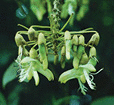

 One of the most amazing examples of symbiosis, where two organisms work together to benefit both of them, is the relationship between the nectar-drinking bat Glossophaga commissarisi and the flower Mucuna holtonii. This central American bat is the size of your thumbnail and pollinates this plant that in turn supplies the bat with nectar. Since the bat is nocturnal, there has to be a very special design involved in getting the two together because sight and color are not available. The way this is done is for the flower to be very carefully designed to fit the bat's senses and body structure.
One of the most amazing examples of symbiosis, where two organisms work together to benefit both of them, is the relationship between the nectar-drinking bat Glossophaga commissarisi and the flower Mucuna holtonii. This central American bat is the size of your thumbnail and pollinates this plant that in turn supplies the bat with nectar. Since the bat is nocturnal, there has to be a very special design involved in getting the two together because sight and color are not available. The way this is done is for the flower to be very carefully designed to fit the bat's senses and body structure.
At dusk, the mucuna's buds open vertically above the blossom. Two tiny side petals spread like wings revealing a crack at the top of the pod (like a pea pod). From this slit, a scent is emitted which the bat can smell. This draws the bat near the plant, but connecting is still an issue. The plant’s petals are cup-shaped, so the bat’s sonar signal is bounced back with greater strength from the petals than anywhere else on the plant or surrounding material. This allows the bat to fly straight into the blossom where the nectar is.
 The bat crams its head into the cup-shaped opening, and its hooks clamp onto the blossom's base. The bat then tucks its tail and whips its hind feet up. At the same time, the bat's snout has gone into the scent's source where it hits a hidden switch exploding the keel of the pod. As the bat laps up the nectar, spring-loaded anthers burst from the keel of the pod dusting the bat's rump with pollen. As the bat visits other plants, it will pollinate them. This process only takes .2 seconds per plant, the bat can visit several hundred flowers every night.
The bat crams its head into the cup-shaped opening, and its hooks clamp onto the blossom's base. The bat then tucks its tail and whips its hind feet up. At the same time, the bat's snout has gone into the scent's source where it hits a hidden switch exploding the keel of the pod. As the bat laps up the nectar, spring-loaded anthers burst from the keel of the pod dusting the bat's rump with pollen. As the bat visits other plants, it will pollinate them. This process only takes .2 seconds per plant, the bat can visit several hundred flowers every night.
Explaining the origin of such a complex system on the basis of chance requires a great deal of faith. It would be simpler to recognize that an intelligence has built a system that allows the efficient pollination of a group of plants so that pollination can occur only at night when predation and competition are minimized. We can really know God exists by looking at what God has made, and this is a great example. Source: National Geographic, March 2014, page 129.
Picture credits:
https://en.wikipedia.org/wiki/Mucuna_holtonii#/media/File:Mucuna_holtonii_2.jpg
https://en.wikipedia.org/wiki/Commissaris's_long-tongued_bat#/media/File:Glossophaga_commissarisi.jpg
